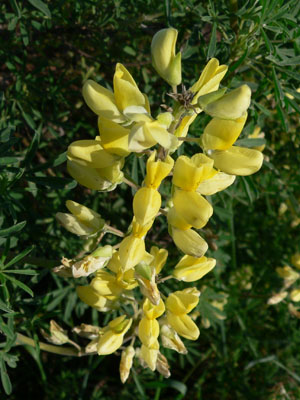
Lupinus arboreus, the yellow bush lupine (US) or tree lupin (UK), is a species of flowering plant in the legume family Fabaceae.
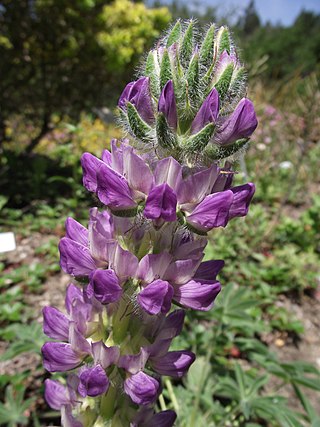
Lupinus microcarpus, the wide-bannered lupine or chick lupine, is a species of lupine native to western North America from southwestern British Columbia south through Oregon and California, including the Mojave Desert, and into Baja California. There is also a disjunct population in South America, with locations in central Chile and western Argentina.
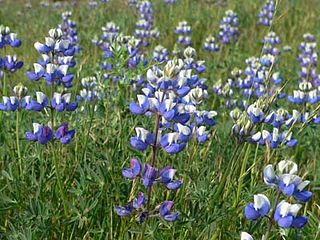
Lupinus nanus, the sky lupine, field lupine, dwarf lupin, ocean-blue lupine or Douglas' annual lupine, is a species of lupine native to the western United States. It is found natively in California, Nevada, and on Steens Mountain in eastern Oregon. It tends to grow on slopes and in open or disturbed areas below 1300 meters.
Lupinus adsurgens is a species of lupine known by the common name Drew's silky lupine. It is native to the Sierra Nevada and coastal mountain ranges of northern California and southern Oregon, where it grows in forest and other mountain habitat.

Lupinus affinis is a species of lupine known by the common name fleshy lupine. It is native to the California Coast Ranges from the San Francisco Bay Area north, and into southern Oregon, where it is an uncommon member of the flora in several areas.
Lupinus andersonii is a species of lupine known by the common name Anderson's lupine.

Lupinus argenteus is a species of lupine known by the common name silvery lupine. It is native to much of western North America from the southwestern Canadian provinces to the southwestern and midwestern United States, where it grows in several types of habitats, including sagebrush, grassland, and forests.
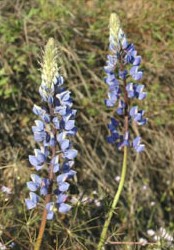
Lupinus benthamii is a species of lupine known by the common name spider lupine.

Lupinus brevicaulis is a species of lupine known by the common names shortstem lupine and sand lupine. It is native to the southwestern United States, including Oregon, California, Nevada, Utah, Colorado, Arizona, and New Mexico, where it grows in many types of sandy habitat.

Lupinus croceus is a species of lupine known by the common names saffron-flowered lupine and Mt Eddy Lupine. It is endemic to the northernmost mountains of California, clustering in the Klamath Mountains, where it grows in generally dry, rocky habitat.
Lupinus elmeri is an uncommon species of lupine known by the common names Elmer's lupine and South Fork Mountain lupine. It is endemic to California, where it is known only from a few scattered occurrences in the northernmost slopes of the North Coast Ranges, in Trinity county.
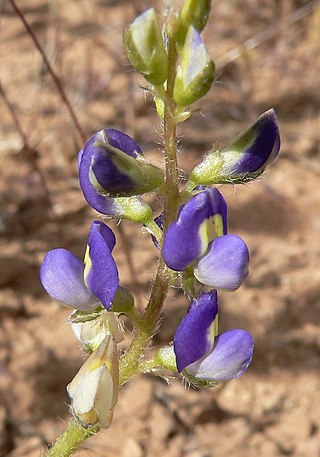
Lupinus flavoculatus is a species of lupine known by the common name yelloweyes, or yellow-eyed lupine.
Lupinus hyacinthinus is a species of lupine known by the common name San Jacinto lupine. It is native to the mountains of southern California and adjacent Baja California, where it grows in dry areas, often in pine forests.
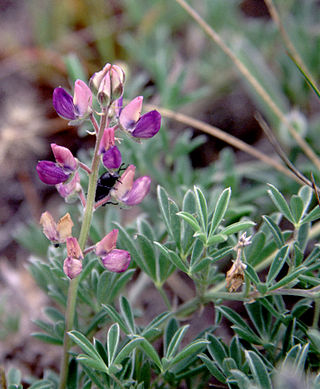
Lupinus littoralis is a species of lupine known by the common name seashore lupine. It is native to the coastline of western North America from British Columbia to northern California, where it grows in sandy habitat.

Lupinus padre-crowleyi is a rare species of lupine known by the common names Father Crowley's lupine and DeDecker's lupine. It is endemic to California, where it is known only from the eastern slopes of the Sierra Nevada and the high plateau below along the western border of Inyo County. It grows in the granite soils of the mountain forests and scrub. It has been noted at fewer than 20 locations. This is a perennial herb growing an erect inflorescence from a mat of silvery, woolly-haired herbage, reaching maximum heights over half a meter. Each palmate leaf is made up of 6 to 9 leaflets up to 7.5 centimeters long. The inflorescence is a raceme of whorled flowers each just over a centimeter long. The flower is cream to pale brownish yellow in color. The fruit is a silky-haired legume pod containing black-mottled white seeds.
Lupinus bingenensis, common name bingen lupine or Suksdorf's lupine, is a plant species native to the US states of Washington, Idaho, Montana and Oregon as well as from British Columbia. Lupinus grows well in mountainous regions. The name honors the city of Bingen, in Klickitat County, Washington.

Lupinus hillii, commonly known as Hill's lupine, is a species of lupine native to Arizona and some parts of New Mexico.
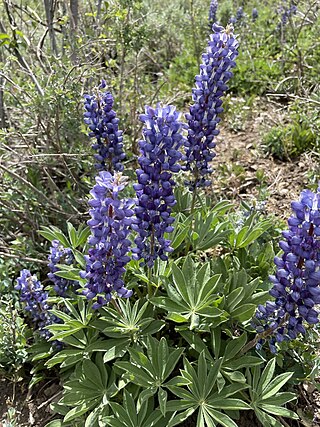
Lupinus prunophilus, commonly known as the hairy bigleaf lupine or chokecherry lupin, is a medium-sized herbaceous plant that grows in the Great Basin and other parts of the U.S. interior between the Sierra-Nevada and the Rockies. It is a close relative and very similar to Lupinus polyphyllus and is considered a subspecies by some botanists.

Lupinus caudatus is a widespread species of wildflower in genus Lupinus from western North America known by the common names tailcup lupin and spurred lupin. It is distinctive for the short spur on its purple-blue flowers, for which it is named. Because of its wide distribution and toxicity it commonly causes poisonings of susceptible livestock such as horses, cattle, and sheep, though it is eaten without harm by wild herbivores like deer and elk. It is generally found from the Coastal Ranges and Sierra Nevada Mountains in the west to the Rocky Mountains in the east.
Lupinus lemmonii, commonly known as Lemmon's lupine, is a species of perennial plant in the family of Fabaceae that is native to Arizona.















